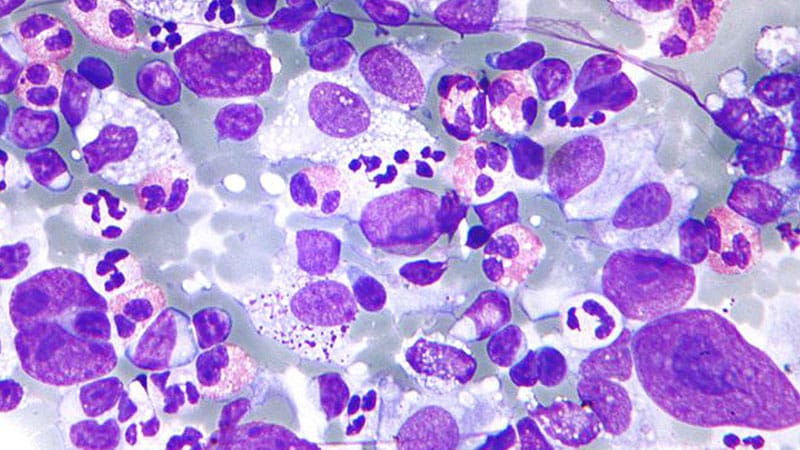Salvage Option for Low-Risk Hodgkin Lymphoma Patients
Core Concepts
Low-risk Hodgkin lymphoma patients may not need autologous stem cell transplant for survival.
Abstract
Children and young adults with low-risk relapsed or refractory classic Hodgkin lymphoma may be able to skip autologous stem cell transplant. Patients who received second-line chemoimmunotherapy with nivolumab-brentuximab vedotin, with or without bendamustine, and proceeded to involved-site radiation appeared to have similar survival outcomes to those who received the chemoimmunotherapy combination plus the current second-line standard of care, which includes high-dose therapy and autologous stem cell transplant.
Key Highlights:
- Study suggests low-risk Hodgkin lymphoma patients may not require high-dose therapy and transplant.
- Results from the phase 2 CheckMate 744 trial presented at ASTRO annual meeting.
- Low-risk patients treated with nivolumab and brentuximab vedotin, followed by involved-site radiation.
- Standard-risk patients received the same chemoimmunotherapy combination and autologous stem cell transplant.
- Positive outcomes observed in low-risk patients without transplant.
- Treatment-related adverse events were manageable with minimal long-term toxicities.
Customize Summary
Rewrite with AI
Generate Citations
Translate Source
To Another Language
Generate MindMap
from source content
Visit Source
www.medscape.com
Salvage Option to Replace Transplant in RR Hodgkin Lymphoma?
Stats
Among 28 patients with low-risk relapsed/refractory Hodgkin lymphoma, 3-year event-free survival without autologous stem cell transplant was 86.9%.
3-year progression-free survival rate for low-risk patients was 95%.
1-year progression-free survival rate for standard-risk patients who received high-dose therapy and autologous stem cell transplant was 91%.
Quotes
"The findings suggest that children, adolescents, and young adults with low-risk relapsed classic Hodgkin lymphoma can be salvaged with low-toxicity chemoimmunotherapy and may not require high-dose therapy and transplant for a cure." - Brad Hoppe, MD, MPH
"The results that Dr. Hoppe showed us are really, really good, and the volume of treatment is pretty tiny, so I think we can safely say that long-term toxicities are very, very minimal." - Andrea Ng, MD, MPH
Key Insights Distilled From
by Neil Osterwe... at www.medscape.com 10-03-2023
https://www.medscape.com/viewarticle/997044
Deeper Inquiries
Is there a risk of undertreatment by skipping autologous stem cell transplant for low-risk Hodgkin lymphoma patients
In the context of low-risk Hodgkin lymphoma patients, the study's findings suggest that skipping autologous stem cell transplant may not necessarily result in undertreatment. The results indicated that patients who received second-line chemoimmunotherapy with nivolumab-brentuximab vedotin, with or without bendamustine, followed by involved-site radiation had comparable survival outcomes to those who underwent high-dose therapy and autologous stem cell transplant. The 3-year event-free survival rate without transplant was 86.9%, and the 3-year progression-free survival rate was 95%, showcasing promising results for this approach. While the number of patients in the study was small and the follow-up duration limited, the data suggests that low-risk Hodgkin lymphoma patients may achieve favorable outcomes without undergoing autologous stem cell transplant, potentially avoiding the associated risks and complications.
Could the findings of this study lead to a shift in the standard treatment approach for relapsed or refractory Hodgkin lymphoma
The findings of this study could indeed lead to a significant shift in the standard treatment approach for relapsed or refractory Hodgkin lymphoma. Traditionally, autologous stem cell transplant has been a cornerstone in the management of these patients, based on older studies. However, the CheckMate 744 trial introduced a risk-adapted and response-adapted treatment strategy that demonstrated promising outcomes for low-risk patients without the need for transplant. If further research confirms these results and establishes the efficacy and safety of this approach, it could revolutionize the treatment paradigm for Hodgkin lymphoma. Moving away from routine autologous stem cell transplant in low-risk cases could spare patients from the potential toxicities and long-term complications associated with transplant, offering a more tailored and potentially less aggressive treatment option.
How can risk-adapted and response-adapted treatment approaches impact the overall outcomes for Hodgkin lymphoma patients
Risk-adapted and response-adapted treatment approaches have the potential to significantly impact the overall outcomes for Hodgkin lymphoma patients by personalizing therapy based on individual risk profiles and treatment responses. In the context of the CheckMate 744 trial, stratifying patients into low-risk and standard-risk categories allowed for tailored treatment strategies that optimized outcomes. Low-risk patients received a less intensive regimen, avoiding autologous stem cell transplant, yet achieving favorable survival rates. This approach not only minimizes overtreatment but also reduces the risk of unnecessary toxicities and complications associated with aggressive therapies. By adapting treatment based on risk factors and response to initial therapy, clinicians can optimize outcomes, improve quality of life, and potentially redefine the standard of care for Hodgkin lymphoma. This personalized approach may pave the way for more effective and targeted treatments in the future, enhancing patient outcomes and minimizing treatment-related morbidity.
0
